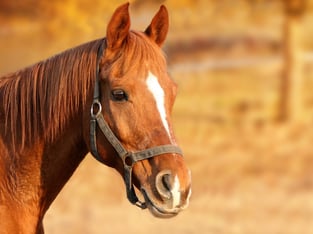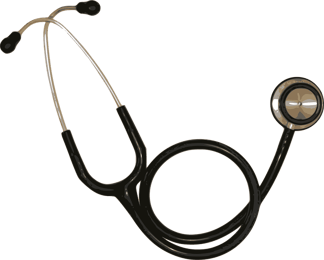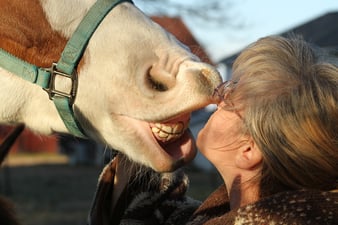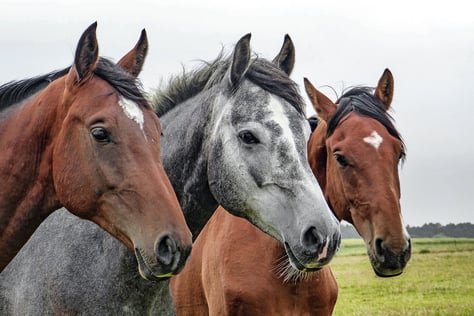Knowing how your horse acts and reacts when he is feeling good will help you to realize when there is something wrong. Every horse owner needs to know what is “normal” for their horse. Being able to report when your horse is uneasy will help evaluate whether a visit to the veterinarian is necessary and how quickly your horse needs to be seen.  Get a baseline of your horse’s temperature, pulse, and respiration (T-P-R) when he is healthy and relaxed. You may also want additional readings in both the summer and winter months and after a workout to know what is normal for your horse in different circumstances.
Get a baseline of your horse’s temperature, pulse, and respiration (T-P-R) when he is healthy and relaxed. You may also want additional readings in both the summer and winter months and after a workout to know what is normal for your horse in different circumstances.
What you’ll need:
- Watch that counts seconds
- Thermometer
- Stethoscope
- Notepad or record book to record vitals
TEMPERATURE:
The normal temperature for an adult horse is roughly 99.5-101.5 degrees. However, a horse’s temperature can vary somewhat with the season. During the winter, your horse’s “normal” temperature may drop several degrees, but low temperatures generally are not causes for concern. On the other hand, summer heat, as well as exercise, can often raise a horse’s temperature a few degrees. These circumstances must also be taken into account when determining if there is cause for concern.
It is easiest to take your horse’s temperature rectally with a clean digital thermometer. Coating the tip of the thermometer with petroleum jelly can make it easier for you to insert and more comfortable for your horse. Always tie a string to the end of the thermometer to make sure you can retrieve it. You can also briefly wrap your horse’s dock in a bandage to make it easier to push the tail hair away to insert the thermometer. Most thermometers will beep when the maximum temperature has been reached.
If your horse’s temperature is over 102 F, you should call your veterinarian.
PULSE:
The pulse rate is taken by listening to the heart, located on the left side of the chest just behind the elbow. You can also take the pulse at the thick facial artery that runs underneath the cheekbone on either side of your horse’s face. Place three fingers (never your thumb which has its own pulse) on the artery and press upward and inward.
Using a stethoscope can often make hearing and counting the heartbeats easier. Some people listen to the heart rate for 10 seconds and then multiply by 6, or 30 seconds and multiply by 2. However, if you have any questions, listen to the pulse rate for the full minute.
The average pulse rate is 40 beats per minute.
Knowing your horse's fitness condition and age is important as more fit horses can have a lower rate and younger horses and ponies can sometimes have a bit faster rate.
Rates between 40-60 are considered “serious” but may be explained by an elevated temperature such as on a very hot day. Also, if the horse is suddenly frightened or excited, his heart rate can become temporarily elevated. Wait a few minutes and then recheck to see if the rate comes down when he is more relaxed. However, rates above 80 are considered “critical” and should be monitored.
Note: ANY rate above 40, even 44, should be regarded with suspicion and evaluated in the overall picture of how the horse is feeling.
RESPIRATION:
Respiration is how hard your horse is breathing. Watch his sides as he breathes in and out and count the number of complete breaths. Deep heavy breathing, or breathing with an extra-abdominal effort, abnormal noise, labored breathing, or gasping are all indications of a problem.
The normal rate for horses is between 8-12 breaths per minute. Again, many things can affect this that must be taken into consideration before considering whether it is abnormal. One common factor is his temperature, excitement, or a heavy workout.
 OTHER VITAL SIGNS:
OTHER VITAL SIGNS:
While temperature, pulse, and respiration are the three most common vital signs used to determine your horse’s health, there are other indicators that you may want to check and report to your veterinarian:
-Mucous Membrane Color: The normal color is pink
-Capillary Refill Time: After depressing the gums, the color should return within 1-2 seconds.
-Gut sounds (borborygmus): A horse should have a normal gurgling sound on both sides of the abdomen back near the flanks.
-Hydration: Pinch and elevate the horse’s skin over the shoulder, then let go. If it snaps back into place very quickly, your horse is properly hydrated.



